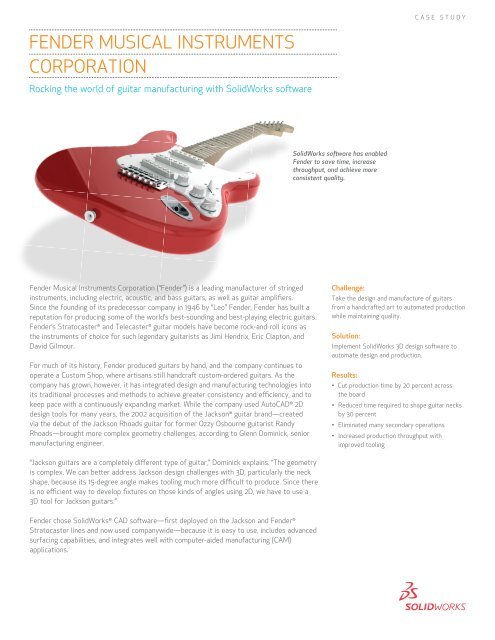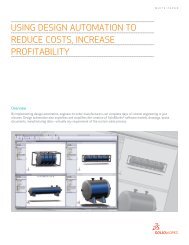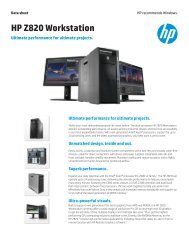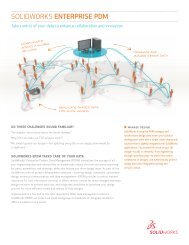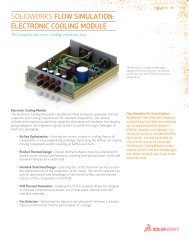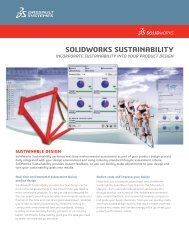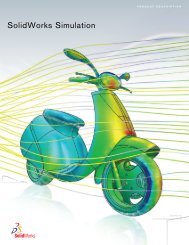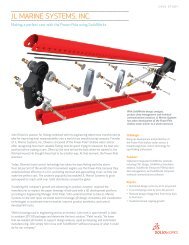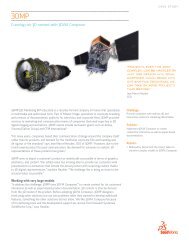FENDER MUSICAL INSTRUMENTS CORPORATION - SolidWorks
FENDER MUSICAL INSTRUMENTS CORPORATION - SolidWorks
FENDER MUSICAL INSTRUMENTS CORPORATION - SolidWorks
You also want an ePaper? Increase the reach of your titles
YUMPU automatically turns print PDFs into web optimized ePapers that Google loves.
C A S E S T U D Y<br />
<strong>FENDER</strong> <strong>MUSICAL</strong> <strong>INSTRUMENTS</strong><br />
<strong>CORPORATION</strong><br />
Rocking the world of guitar manufacturing with <strong>SolidWorks</strong> software<br />
<strong>SolidWorks</strong> software has enabled<br />
Fender to save time, increase<br />
throughput, and achieve more<br />
consistent quality.<br />
Fender Musical Instruments Corporation (“Fender”) is a leading manufacturer of stringed<br />
instruments, including electric, acoustic, and bass guitars, as well as guitar amplifiers.<br />
Since the founding of its predecessor company in 1946 by “Leo” Fender, Fender has built a<br />
reputation for producing some of the world’s best-sounding and best-playing electric guitars.<br />
Fender’s Stratocaster ® and Telecaster ® guitar models have become rock-and-roll icons as<br />
the instruments of choice for such legendary guitarists as Jimi Hendrix, Eric Clapton, and<br />
David Gilmour.<br />
For much of its history, Fender produced guitars by hand, and the company continues to<br />
operate a Custom Shop, where artisans still handcraft custom-ordered guitars. As the<br />
company has grown, however, it has integrated design and manufacturing technologies into<br />
its traditional processes and methods to achieve greater consistency and efficiency, and to<br />
keep pace with a continuously expanding market. While the company used AutoCAD ® 2D<br />
design tools for many years, the 2002 acquisition of the Jackson ® guitar brand—created<br />
via the debut of the Jackson Rhoads guitar for former Ozzy Osbourne guitarist Randy<br />
Rhoads—brought more complex geometry challenges, according to Glenn Dominick, senior<br />
manufacturing engineer.<br />
Challenge:<br />
Take the design and manufacture of guitars<br />
from a handcrafted art to automated production<br />
while maintaining quality.<br />
Solution:<br />
Implement <strong>SolidWorks</strong> 3D design software to<br />
automate design and production.<br />
Results:<br />
• Cut production time by 20 percent across<br />
the board<br />
• Reduced time required to shape guitar necks<br />
by 30 percent<br />
• Eliminated many secondary operations<br />
• Increased production throughput with<br />
improved tooling<br />
“Jackson guitars are a completely different type of guitar,” Dominick explains. “The geometry<br />
is complex. We can better address Jackson design challenges with 3D, particularly the neck<br />
shape, because its 15-degree angle makes tooling much more difficult to produce. Since there<br />
is no efficient way to develop fixtures on those kinds of angles using 2D, we have to use a<br />
3D tool for Jackson guitars.”<br />
Fender chose <strong>SolidWorks</strong> ® CAD software—first deployed on the Jackson and Fender ®<br />
Stratocaster lines and now used companywide—because it is easy to use, includes advanced<br />
surfacing capabilities, and integrates well with computer-aided manufacturing (CAM)<br />
applications.
Redesigning manufacturing processes<br />
On the Jackson line, Fender redesigned its manufacturing processes to accommodate the<br />
line’s more intricate and complex shapes, as well as to take advantage of automation.<br />
“<strong>SolidWorks</strong> software has enabled us to improve our secondary manufacturing processes<br />
with CNC machining,” Dominick stresses. “Because we have an accurate, precise 3D model<br />
of the guitar body, we can take advantage of the efficiencies associated with programming<br />
tooling paths and procedures using automated equipment.<br />
“<strong>SolidWorks</strong> has enabled us<br />
to improve our secondary<br />
manufacturing processes<br />
with CNC machining.”<br />
Glen Dominick<br />
Senior Manufacturing Engineer<br />
“Since we began using <strong>SolidWorks</strong> software, we have been able to complete the most<br />
difficult step—developing the neck back shape—30 percent faster,” he adds. “That’s just<br />
one example of how <strong>SolidWorks</strong> software is helping us cut time and manual steps from the<br />
process. By using <strong>SolidWorks</strong> software, we have reduced manufacturing time by at least 20<br />
percent across the board, and have boosted production throughput by creating better tooling<br />
and taking advantage of better CAM programming.”<br />
Meeting demands for greater consistency, better performance<br />
In addition to saving time and increasing throughput, <strong>SolidWorks</strong> software is helping Fender<br />
achieve more consistent quality and an equally high level of performance from instrument<br />
to instrument. “With a hand-built guitar, you want every guitar to be different and have<br />
its own sound. But with a production model, you want to standardize shape, quality, and<br />
performance,” Dominick points out. “A Fender Master Builder can use a lot of tricks and<br />
extra sanding to finesse the handcrafted instrument to achieve what he wants. On production<br />
models, we want to produce the same level of quality performance over and over again.<br />
“Using <strong>SolidWorks</strong> software, we know that the notes are going to intonate correctly and<br />
that we will produce more consistent playing instruments,” he adds. “<strong>SolidWorks</strong> software<br />
helps us achieve consistency through a higher degree of accuracy and greater levels of<br />
automation.”<br />
Standardizing across all production facilities<br />
Fender first used <strong>SolidWorks</strong> software to design a recent Stratocaster guitar model at its<br />
facility in Baja California (Mexico) and to drive manufacturing of the Jackson line. Since then,<br />
Fender has standardized on <strong>SolidWorks</strong> software across all products and facilities, and now<br />
operates more than 20 seats of <strong>SolidWorks</strong> software throughout the company.<br />
“We have standardized on <strong>SolidWorks</strong> software across the operation, from research and<br />
development through manufacturing,” Dominick notes. “Working on the same 3D platform<br />
makes it easier to share ideas and furthers our goal to produce consistently high-quality<br />
guitars with less effort and fewer manual operations.”<br />
With <strong>SolidWorks</strong> software, Fender can take<br />
advantage of more complex shapes and<br />
automated production processes.<br />
Fender Musical Instruments<br />
Corporation<br />
311 Cessna Circle<br />
Corona, CA 92880<br />
Phone: +1 951 898 4000<br />
www.fender.com<br />
VAR: Go Engineer,<br />
Santa Clara, California<br />
Dassault Systèmes<br />
<strong>SolidWorks</strong> Corp.<br />
300 Baker Avenue<br />
Concord, MA 01742 USA<br />
Phone: 1 800 693 9000<br />
Outside the US: +1 978 371 5011<br />
Email: info@solidworks.com<br />
www.solidworks.com<br />
<strong>SolidWorks</strong> is a registered trademark of Dassault Systèmes <strong>SolidWorks</strong> Corp. All other company and product names are trademarks<br />
or registered trademarks of their respective owners. ©2010 Dassault Systèmes. All rights reserved. MKFENCSENG1110


